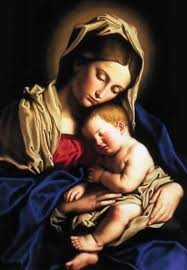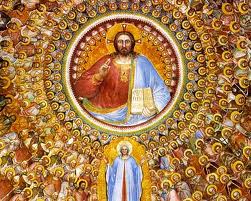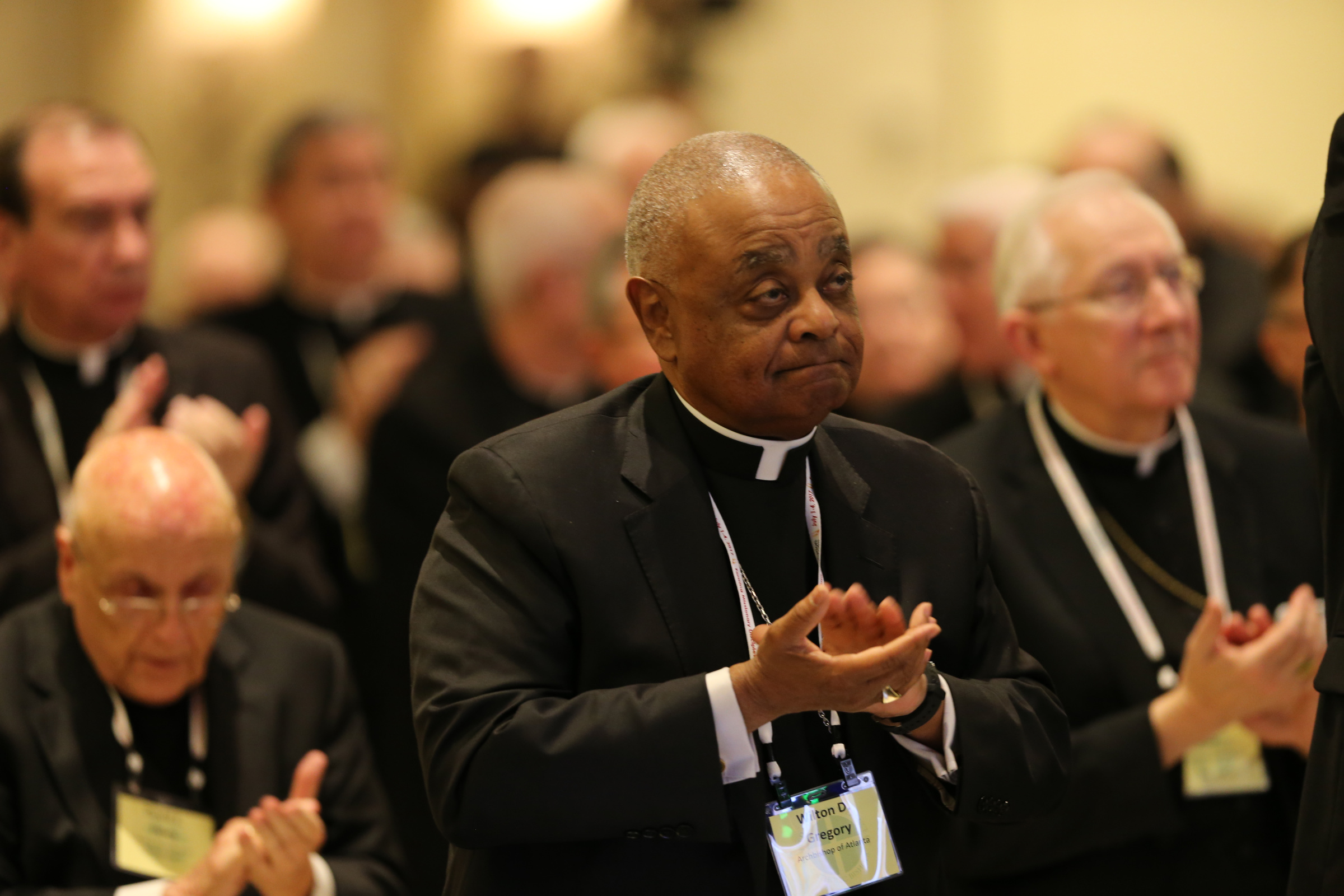The Immaculate Conception

Romans 3:23 says, “All have sinned and fallen short of the glory of God.” I John 1:8 adds, “If any man says he has no sin he is a liar and the truth is not in him.” These texts could not be clearer for millions of Protestants: “How could anyone believe Mary was free from all sin in light of these Scriptures? What’s more, Mary herself said, ‘My soul rejoices in God my savior’ in Luke 1:47. She clearly understood herself to be a sinner if she admits to needing a savior.”
The Catholic Answer
Not a few Protestants are surprised to discover the Catholic Church actually agrees that Mary was “saved.” Indeed, Mary needed a savior! However, Mary was “saved” from sin in a most sublime manner. She was given the grace to be “saved” completely from sin so that she never committed even the slightest transgression. The problem here is Protestants tend to emphasize God’s “salvation” almost exclusively to the forgiveness of sins actually committed. However, Sacred Scripture indicates that salvation can also refer to man being protected from sinning before the fact.
Now to him who is able to keep you from falling and to present you without blemish before the presence of his glory with rejoicing, to the only God, our Savior through Jesus Christ our Lord, be glory, majesty, dominion, and authority, before all time and now and for ever (Jude 24-25).
The great Franciscan theologian, Duns Scotus, explained ca. 600 years ago that falling into sin could be likened to a man approaching unaware a massive 20-feet deep ditch. If he falls into the ditch, he would need someone to lower a rope and save him. But if someone were to warn him of the danger ahead resulting in the man not falling into the ditch at all, he would have been saved from falling in the first place. Analogously, Mary was saved from sin by receiving the grace to be preserved from it. But she was still saved.
The Exception[s] to the Rule
But what about “all have sinned,” and “if any man says he has no sin he is a liar and the truth is not in him?” Wouldn’t “all” and/or “any man” include Mary? On the surface, this sounds reasonable. But this way of thinking carried to its logical conclusion would list Jesus Christ in the company of sinners as well. No Christian would dare say that! Yet, no Christian can deny the plain texts of Scripture declaring Christ’s full humanity either. Thus, if one is going to take I John 1:8 in a strict, literal sense, then any man would apply to Jesus as well!
The truth is—and all Christians agree—Jesus Christ was an exception to Romans 3:23 and I John 1:8. And the Bible tells us he was in Hebrews 4:15: “Christ was tempted in all points even as we are and yet he was without sin.” The real question now is: are there any other exceptions to this rule? Yes, there are. In fact, there are millions of them.
First of all, we need to recall that both of these texts—Romans 3:23 and I John 1:8—are dealing with personal rather than original sin. Romans 5:12 will deal with original sin. And there are two exceptions to that general biblical norm as well. But for now, we will simply deal with Romans 3:23 and I John 1:8. I John 1:8 obviously refers to personal sin because in the very next verse, St. John tells us, “If we confess our sins, he is faithful and just to forgive us our sins…” We do not confess original sin; we confess personal sins.
The context of Romans 3:23 makes clear that it too refers to personal sin:
None is righteous, no, not one; no one understands, no one seeks for God. All have turned aside, together they have gone wrong; no one does good, not even one. Their throat is an open grave. They use their tongues to deceive. The venom of asps is under their lips. Their mouth is full of curses and bitterness (Romans 3:10-14).
Original sin is not something we do; it is something we’ve inherited. Romans chapter three deals with personal sin because it speaks of sins committed by the sinner. With this in mind, consider this: Has a baby in the womb or a child of two ever committed a personal sin? No, they haven’t (see Romans 9:11)! Or, how about the mentally challenged who do not have the use of their intellects and wills? These cannot sin because in order to sin a person has to know the act he is about to perform is sinful while freely engaging his will in carrying it out. Without the proper faculties to enable them to sin, children before the age of accountability and anyone who does not have the use of his intellect and will cannot sin. Right there you have millions of exceptions to Romans 3:23 and I John 1:8.
The question remains: how do we know Mary is an exception to the norm of “all have sinned?” And more specifically, is there biblical support for this claim? Yes, there is. Indeed, there is much biblical support, but in this brief post I shall cite just five examples, among the many to which I could refer, that give us biblical support for this ancient doctrine of the Faith.
1. LUKE 1:28:
And [the angel Gabriel] came to [Mary] and said, “Hail, full of grace, the Lord is with you!” But she was greatly troubled at the saying, and considered in her mind what sort of greeting this might be. And the angel said to her, “Do not be afraid, Mary, for you have found favor with God.”
Many Protestants will insist this text to be little more than a common greeting of the Archangel Gabriel to Mary. “What would this have to do with Mary being without sin?” Yet, the truth is, according to Mary herself, this was no common greeting. The text reveals Mary to have been “greatly troubled at the saying and considered in her mind what sort of greeting this might be” (Luke 1:29, emphasis added). What was it about this greeting that was so uncommon for Mary to react this way? There are at least two key reasons:
First, according to many biblical scholars as well as Pope John Paul II, the angel did more than simply greet Mary. The angel actually communicated a new name or title to her. In Greek, the greeting was kaire, kekaritomene, or “Hail, full of grace.” Generally speaking, when one greeted another with kaire, a name or title would almost be expected to be found in the immediate context. “Hail, king of the Jews” in John 19:3 and “Claudias Lysias, to his Excellency the governor Felix, greeting” (Acts 23:26) are two biblical examples of this. The fact that the angel replaces Mary’s name in the greeting with “full of grace” was anything but common. This would be analogous to me speaking to one of our tech guys at Catholics answers and saying, “Hello, he who fixes computers.” In our culture, I would just be considered weird. But in Hebrew culture, names, and name changes, tell us something that is permanent about the character and calling of the one named. Just recall the name changes of Abram to Abraham (changed from “father” to “father of the multitudes”) in Gen. 17:5, Saray to Sarah (“my princess” to “princess”) in Gen. 17:15, and Jacob to Israel (“supplanter” to “he who prevails with God”) in Gen. 32:28.
In each case, the names reveal something permanent about the one named. Abraham and Sarah transition from being a “father” and “princess” of one family to being “father” and “princess” or “mother” of the entire people of God (see Romans 4:1-18; Is. 51:1-2). They become Patriarch and Matriarch of God’s people forever. Jacob/Israel becomes the Patriarch whose name, “he who prevails with God,” continues forever in the Church, which is called “the Israel of God” (Gal. 6:16). The people of God will forever “prevail with God” in the image of the Patriarch Jacob who was not just named Israel, but he truly became “he who prevails with God.”
An entire tome could be written concerning the significance of God’s revelation of his name in Exodus 3:14-15 as I AM. God revealed to us volumes about his divine nature in and through the revelation of his name—God is pure being with no beginning and no end; he is all perfection, etc.
What’s in a name? A lot according to Scripture!
When you add to this the fact that St. Luke uses the perfect passive participle, kekaritomene, as his “name” for Mary, we get deeper insight into the meaning of Mary’s new name. This word literally means “she who has been graced” in a completed sense. This verbal adjective, “graced,” is not just describing a simple past action. Greek has the aorist tense for that. The perfect tense is used to indicate that an action has been completed in the past resulting in a present state of being. That’s Mary’s name! So what does it tell us about Mary? Well, the average Christian is not completed in grace and in a permanent sense (see Phil. 3:8-12). But according to the angel, Mary is. You and I sin, not because of grace, but because of a lack of grace, or a lack of our cooperation with grace, in our lives. This greeting of the angel is one clue into the unique character and calling of the Mother of God.
Objection!
One objection to the above is rooted in Eph. 2:8-9. Here, St. Paul uses the perfect tense and passive voice when he says, “For by grace you have been saved…” Why wouldn’t we then conclude all Christians are complete in salvation for all time? There seems to be an inconsistency in usage here.
Actually, the Catholic Church understands that Christians are completed in grace when they are baptized. In context, St. Paul is speaking about the initial grace of salvation in Ephesians two. The verses leading up to Eph. 2:8-9, make this clear: “… we all lived in the passions of our flesh, following the desires of body and mind, and so we were by nature children of wrath…even when we were dead in trespasses and sins…(by grace you have been saved)” (vss. 3-5). But there is no indication here, as there is with Mary, that the Christian is going to stay that way. In other words, Eph. 2:8-9 does not confer a name.
In fact, because of original sin, we can guarantee that though we are certainly perfected in grace through baptism, ordinarily speaking, we will not stay that way after we are baptized; that is, if we live for very long afterward (see I John 1:8)! There may be times in the lives of Christians when they are completed or perfected in grace temporarily. For example, after going to confession or receiving the Eucharist well-disposed. We let God, of course, be the judge of this, not us, as St. Paul tells us in I Cor. 4:3-4:
I do not even judge myself. I am not aware of anything against myself, but I am not thereby acquitted (Gr.—justified). It is the Lord who judges me.
But only Mary is given the name “full of grace” and in the perfect tense indicating that this permanent state of Mary was completed.
2. An Ancient Prophecy—Genesis 3:15:
Genesis 3:15 is often referred to by biblical scholars as the Protoevangelium. It is a sort of “gospel” before “the gospel.” This little text contains in very few words God’s plan of salvation which would be both revealed and realized in the person of Jesus Christ. Yet, when one reads the text, one cannot help but note that this prophetic woman seems to have what could be termed almost a disturbing prominence and importance in God’s providential plan:
I will put enmity between you and the woman, and between your seed and her seed: he shall bruise your head, and you shall bruise his heel.
Not only do we have the Virgin Birth here implied because the text says the Messiah would be born of “the seed of the woman” (the “seed” is normally of the man), but notice “the woman” is not included as “the seed” of the devil. It seems that both the woman and her seed are in opposition to and therefore not under the dominion of the devil and “his seed,” i.e., all who have original sin and are “by nature children of wrath” as St. Paul puts it in Eph. 2:3. Here, we have in seed form (pun intended), the fact that the woman—Mary—would be without sin, especially original sin, just as her Son—the Messiah—would be. The emphasis on Mary is truly remarkable in that the future Messiah was only mentioned in relation to her. There can be little doubt that a parallel is being drawn between Jesus and Mary and their absolute opposition to the devil.
3. Mary, Ark of the Covenant:
The Old Testament ark of the Covenant was a true icon of the sacred. It was a picture of the purity and holiness God fittingly demands of those objects and/or persons most closely associated with himself and the plan of salvation. Because it would contain the very presence of God symbolized by three types of the coming Messiah—the manna, the Ten Commandments, and Aaron’s staff—it had to be most pure and untouched by sinful man (see II Sam. 6:1-9; Exodus 25:10ff; Numbers 4:15; Heb. 9:4).
In the New Testament, the new and true Ark would not be an inanimate object, but a person—the Blessed Mother. How much more pure would the new and true Ark be when we consider the old ark was a mere “shadow” in relation to it (see Heb. 10:1)? This image of Mary as the Ark of the Covenant is an indicator that Mary would fittingly be free from all contagion of sin in order for her to be a worthy vessel to bear God in her womb. And most importantly, just as the Old Covenant ark was pristine from the moment it was constructed with explicit divine instructions in Exodus 25, so would Mary be most pure from the moment of her conception. God, in a sense, prepared his own dwelling place in both the Old and New Testaments.
4. Mary, the “New Eve” of the New Covenant:
It is important for us to recall, as I mentioned briefly above, that New Covenant fulfillments are always more glorious and more perfect than their Old Testament types, which are “but a shadow of the good things to come” in the New Covenant (Heb. 10:1). With this New Testament truth in mind, let us consider the New Testament revelation of Mary to be the antitype of Eve, or the “New Eve.” After the fall of Adam and Eve in Gen. 3, God promised the advent of another “woman” in Gen. 3:15, or a “New Eve” who would oppose Lucifer, and whose “seed” would crush his head. This “woman” and “her seed” would reverse the curse, so to speak, that the original “man” and “woman” had brought upon humanity through their disobedience.
It is most significant here to note “Adam” and “Eve” are revealed simply as “the man” and “the woman” before the woman’s name was changed to “Eve” (Heb.—Mother of the living) after the fall (See Gen. 2:21ff). When we then look at the New Covenant, Jesus is explicitly referred to as the “last Adam,” or the “New Adam” in I Cor. 15:45. And Jesus himself indicates Mary to be the prophetic “woman” or “New Eve” of Gen. 3:15 when he refers to his mother as “woman” in John 2:5 and 19:26. Moreover, St. John refers to Mary as “woman” eight times in Rev. 12. As the first Eve brought death to all of her children through disobedience and heeding the words of the ancient Serpent, the devil, the “New Eve” of Revelation 12 brings life and salvation to all of her children through her obedience. The same “serpent” who deceived the original woman of Genesis is revealed, in Revelation 12, to fail in his attempt to overcome this New Woman. The New Eve overcomes the serpent and as a result, “The serpent is angry with the woman, and went off to make war on the rest of her offspring, on those who keep the commandments of God, and bear testimony to Jesus” (Rev. 12:17).
If Mary is the New Eve, and New Testament fulfillments are always more glorious than their Old Testament antecedents, it would be unthinkable for Mary to be conceived in sin. If she were, she would be inferior to Eve who was created in a perfect state, free from all sin.
5. Mary, the Beginning of the New Creation:
Jeremiah 31:22 presents another fascinating prophecy concerning the coming of the “New Woman” and the New Covenant. In the midst of this well-known chapter famous for its prophecy concerning the coming of the New Covenant (see Jeremiah 31:31, which is quoted in Heb. 8:8), we read: “For the Lord hath created a new thing upon the earth. A WOMAN SHALL COMPASS A MAN” (DRV). St. Jerome, in the fourth century, comments on this text:
“Can a bride forget her jewels, or a virgin her girdle” (Jer. 2:32) Always in this very prophecy it is said that a great miracle occurred involving this woman: The woman will surround the man and the virgin’s womb will contain the parent of all.
In the first covenant, the man “compassed” or “encompassed” the woman. The woman came from the rib of the man. In the New Covenant, “the New Man,” or “New Adam”—Jesus—would come from the womb of “the Woman”—or “New Eve.” It is Mary that would “compass” Jesus.
Many fathers of the Church, in agreement with St. Jerome, will see from this and other biblical texts Mary as the “new earth” or “new land” out of which God would form the “New Adam.” Consider St. Jerome’s Tractus de Psalmo 66 and 96 (these are commentaries on the Psalms). When considering Psalm 66, St. Jerome sees Jesus and Mary in both the “flower and the Lily” of Song of Solomon 2:1 and the “fruits of the earth” from Psalm 66 (67):6:
Do you want to know what this fruit is? It is the virgin from the Virgin, the Lord from the handmaid, God from a human creature, the Son from a mother, the fruit from the earth.
St. Jerome here refers to Mary as “the earth.” He says something similar in his commentary on Psalm 96. He speaks of the promised land to David as being Mary:
The land of David is holy Mary, Mother of the Lord, “who was born of David’s seed according to the flesh” (Romans 1:3). What was promised to David was fulfilled in Mary’s virginity and birth, where a virgin is born from a Virgin.
Mary is the new earth out of which would be formed the New Adam. Just as God formed the first Adam from a pristine earth untouched by the curse of original sin, so God would bring the “New Adam” from a “New Land” or “New Earth” that would also most fittingly be pristine and untouched by sin. The first creation began without sin, so the New Creation would begin without sin as well. The first Eve would fall from grace; the New Eve would not.
If you liked this blog post, and if you would like more information about this topic and more, click here.






